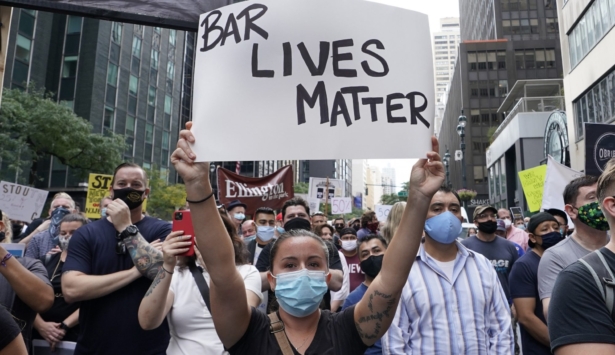New York Gov. Andrew Cuomo said on Monday if hospitalizations from the CCP virus in the state keep rising in the coming days, restaurants will likely face new restrictions.
The governor said officials will monitor the different regions’ hospital capacities in the state for the coming five days, noting that if the rates don’t stabilize, a ban or reduction on indoor dining is possible, starting as soon as Dec. 14.
“We’re going to monitor the hospital capacity. If it doesn’t stabilize we’re going to reduce the indoor dining restrictions. They go to zero in New York City, 25 percent everywhere else in the state,” Cuomo said during a press briefing.
NEW: If after 5 days a region’s hospital rate has not stabilized, indoor dining will close or be reduced.
-In NYC, indoor dining would close entirely.
-In rest of the state, indoor dining would be reduced to 25% capacity.
— Andrew Cuomo (@NYGovCuomo) December 7, 2020
According to state data on total hospitalizations in New York City, as of Dec. 6, 1,416 New Yorkers are currently in hospital with COVID-19. This is up 41 from a day earlier when data shows 1,375 people were hospitalized with the CCP (Chinese Communist Party) virus.
Across the whole state, the data shows 4,602 people hospitalized, which is an additional 160 patients from a day earlier, when 4,442 patients were in the hospital.
Cuomo said of those 160 patients, 22 were being admitted to the intensive care unit, and 13 others intubated. A total of 80 people have died.
“There are certain absolutes, OK? What is the absolute here? You cannot overwhelm your hospitals,” Cuomo said during the briefing.
“If you are at a rate that is going to overwhelm your hospitals, you must shut down,” he added.
Today’s update on the numbers:
Total COVID hospitalizations are at 4,602.
Of the 152,287 tests reported yesterday, 7,302 were positive (4.79% of total).
Sadly, there were 80 fatalities. pic.twitter.com/KdJtaFqpqA
— Andrew Cuomo (@NYGovCuomo) December 7, 2020
The governor warned earlier this year after the city started reopening that if hospitalizations rose again for 10 consecutive days with a seven-day positivity rate of three percent or higher, indoor dining may be reduced or banned. The number is now past that, at four percent, according to state data.
Cuomo noted that only indoor dining will be closed in New York City or work on a reduced capacity in other regions if the hospitalization rate doesn’t stabilize in the coming days. Pickup and delivery services would still be allowed.
“The CDC has targeted indoor dining as a spreader,” he told a reporter after she asked the governor why only indoor dining will face restrictions and not gyms, hair salons, beauty salons, and other similar facilities.
Cuomo also warned that a surge in CCP virus cases is possible with the upcoming holiday season and people traveling across the nation.
“We are looking at continued increases from now until mid-January,” he said. “It’s the beginning of 37 days of a holiday season,” he added.
‘Absolutely Devastating’
Many restaurateurs have expressed their concerns over further restrictions.
“I’m very angry. I’m very upset. You know, we’re a big company, we have restaurants all over the world, so we’re probably going to survive this. But how about the smaller restaurants? They probably can’t survive,” Peter Guimaraes of BICE told CBS New York.
Another restaurateur told the network another shutdown would be “absolutely devastating for our local restaurants and workers.”
“We can’t continue to get shutdown without being supported,” said Andrew Rigie, who represents 2,500 of the city’s 24,000 eateries.

Meanwhile, the co-owner of a New York City bar that authorities said has been defying CCP virus restrictions was taken into custody over the weekend after running over a deputy with a car, authorities said.
The tavern is in an area designated by Cuomo as an orange zone because of spiking COVID-19 rates and was not supposed to be serving customers indoors. But the owners had declared the bar an “autonomous zone,” a nod to protesters who claimed control over a Seattle neighborhood in June.
The Associated Press contributed to this report.

